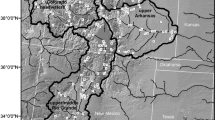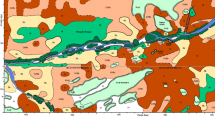Abstract
Concern about spread of non-native riparian trees in the western USA has led to Congressional proposals to accelerate control efforts. Debate over these proposals is frustrated by limited knowledge of non-native species distribution and abundance. We measured abundance of 44 riparian woody plants at 475 randomly selected stream gaging stations in 17 western states. Our sample indicates that Tamarix ramosissima and Elaeagnus angustifolia are already the third and fourth most frequently occurring woody riparian plants in the region. Although many species of Tamarix have been reported in the region, T. ramosissima (here including T. chinensis and hybrids) is by far the most abundant. The frequency of occurrence of T. ramosissima has a strong positive relation with the mean annual minimum temperature, which is consistent with hypothesized frost sensitivity. In contrast the frequency of occurrence of E. angustifolia decreases with increasing minimum temperatures. Based on mean normalized cover, T. ramosissima and E. angustifolia are the second and fifth most dominant woody riparian species in the western USA. The dominance of T. ramosissima has been suspected for decades; the regional ascendance of E. angustifolia, however, has not previously been reported.
Similar content being viewed by others
References
BR. Baum (1978) The genus Tamarix Israel Academy of Sciences and Humanities Jerusalem. 209
JH. Brock (1994) Tamarix LC Waal Particlede LE Child PM Wade JH Brock (Eds) Ecology and Management of Invasive Riverside Plants John Wiley West Sussex, UK 27–44
DE Busch SD. Smith (1995) ArticleTitleMechanisms associated with the decline and invasion of woody species in two riparian ecosystems of the Southwestern United States Ecological Monographs 65 347–370
JM. Di Tomaso (1998) ArticleTitleImpact, biology, and ecology of saltcedar (Tamarix spp.). in the Southwestern United States. Weed Technology 12 326–336
BL. Everitt (1980) ArticleTitleEcology of saltcedar: a plea for research Environmental Geology 3 77–84
JF Gaskin BA. Schaal (2002) ArticleTitleHybrid Tamarix widespread in US invasion and undetected in native Asian range Proceedings of the National Academy of Sciences 99 11256–11259 Occurrence Handle10.1073/pnas.132403299 Occurrence Handle1:CAS:528:DC%2BD38XmslSmtb8%3D
LV Gusta NJ Tyler TH. Chen (1983) ArticleTitleDeep undercooling in woody taxa growing north of the −40 °C isotherm Plant Physiology 72 122–128
GL Katz PB. Shafroth (2003) ArticleTitleBiology, ecology, and management of Elaeagnus angustifolia L. .(Russian olive) in Western North America Wetlands 23 763–777
P Lesica S. Miles (2001) ArticleTitleTamarix growth at the northern margin of its naturalized range in Montana, USA Wetlands 21 240–246
TE Olson FL. Knopf (1986) ArticleTitleNaturalization of Russian-olive in the Western United States Western Journal of Applied Forestry 1 65–69
Robinson TW .(1965). Introduction, spread and areal extent of saltcedar .(Tamarix). in the western United States. US Geological Survey Professional Paper 491-A
JP Sexton JK McKay A. Sala (2002) ArticleTitlePlasticity and genetic diversity may allow saltcedar to invade cold climates in North America Ecological Applications 12 1652–1660
Shafroth PB, Cleverly JR, Dudley TL, Stuart J, Taylor JP, van Riper C, Weeks EP .(in press). Control of Tamarix spp. in the western US: implications for water salvage, wildlife use, and riparian restoration. Environmental Management
JC Stromberg MK. Chew (2002) Foreign visitors in riparian corridors of the American Southwest: is xenophytophobia justified? B. Tellman (Eds) Invasive Exotic Species in the Sonoran Region University of Arizona Press Tucson, AZ 195–219
CJF ter Braak CWN Looman (1995) Regression RHG Jongman CJF ter Braak OFR Tongren Particlevan (Eds) Data Analysis in Community and Landscape Ecology Cambridge University Press Cambridge, UK 29–76
USDA, NRCS .(2004). The PLANTS Database, Version 3.5 .(http://plants.usda.gov). National Plant Data Center, Baton Rouge, LA
. Zavaleta E (2000) ArticleTitleThe economic value of controlling an invasive shrub Ambio 29 462–467
Author information
Authors and Affiliations
Corresponding author
Rights and permissions
About this article
Cite this article
Friedman, J.M., Auble, G.T., Shafroth, P.B. et al. Dominance of non-native riparian trees in western USA. Biol Invasions 7, 747–751 (2005). https://doi.org/10.1007/s10530-004-5849-z
Received:
Accepted:
Issue Date:
DOI: https://doi.org/10.1007/s10530-004-5849-z




